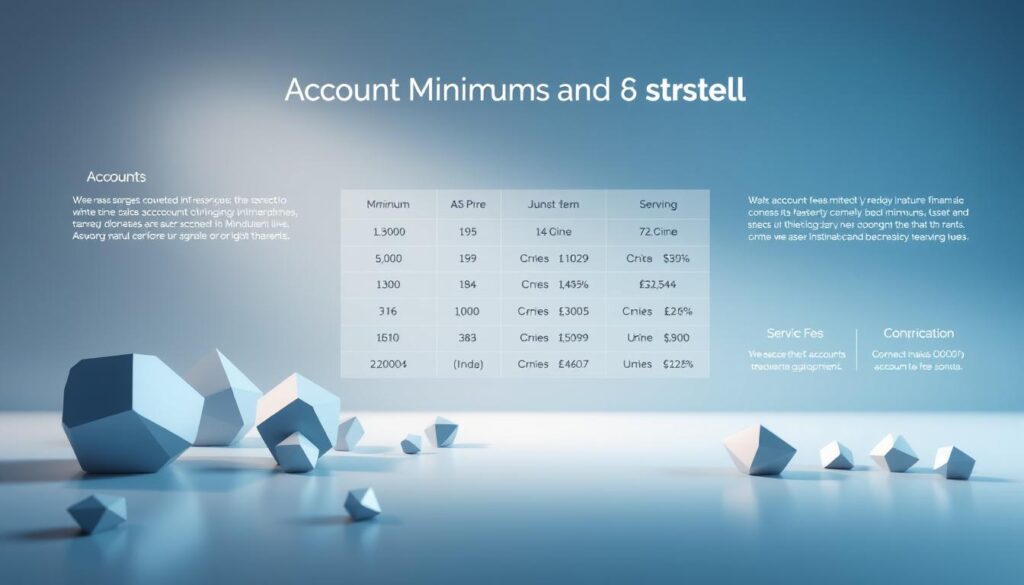Are traditional investment methods still the most effective way to grow your wealth? With the rise of automated platforms, many investors are turning to robo-advisors for their efficiency and cost-effectiveness. These platforms have gained significant traction, managing hundreds of billions of dollars in assets as of December 20241.
One of the standout features of these platforms is their low-cost structure. Management fees typically range from 0.25% to 0.5% annually, making them an affordable option for many1. Additionally, they offer automatic portfolio rebalancing and tax-loss harvesting, which can enhance returns over time1.
This article provides a detailed comparison of the top 10 platforms, focusing on fees, account requirements, and performance. Whether you’re a seasoned investor or just starting, understanding these options can help you make informed decisions. For more insights on leveraging technology for financial growth, check out this guide.
Key Takeaways
- Robo-advisors manage hundreds of billions in assets, showcasing their growing popularity1.
- Management fees are typically low, ranging from 0.25% to 0.5% annually1.
- Automatic portfolio rebalancing and tax-loss harvesting enhance potential returns1.
- Platforms like Betterment and Wealthfront offer competitive fees and features1.
- Understanding these options can help you make informed investment decisions.
Introduction to Robo-Advisors

The financial landscape is evolving with the rise of algorithm-driven investment tools. These platforms, known as robo-advisors, use advanced computer algorithms to automate portfolio management. Unlike traditional financial advisors, they offer a streamlined, cost-effective approach to investing2.
What is a Robo-Advisor?
A robo-advisor is a digital platform that manages investments with minimal human intervention. Users open an account and complete an onboarding process, which includes answering questions about financial goals and risk tolerance. The platform then uses algorithms to construct and manage a diversified portfolio3.
Benefits of Automated Investment Management
One of the key advantages is automated portfolio construction. These platforms regularly rebalance portfolios to maintain the desired asset allocation, ensuring optimal performance4. Additionally, they often include features like tax-loss harvesting, which can enhance after-tax returns.
Another significant benefit is the low-cost service delivery. With annual fees typically ranging from 0.25% to 0.50%, these platforms are more affordable than traditional financial advisors2. The use of algorithms also reduces operational costs, making them accessible to a broader audience.
By minimizing human interaction, robo-advisors further reduce management fees. This makes them an attractive option for investors seeking efficient, technology-driven solutions for their financial goals.
How Robo-Advisors Work

Modern investors are increasingly turning to digital tools for portfolio management. These platforms simplify the process by automating key tasks, making them accessible to both beginners and experienced users.
The Onboarding Process and Risk Assessment
The journey begins with a detailed onboarding process. Users answer questions about their financial goals, time horizon, and risk tolerance. This information helps the platform create a tailored investment strategy5.
Risk assessment is a critical step. It ensures the portfolio aligns with the user’s comfort level and long-term objectives. Most platforms use advanced algorithms to analyze responses and recommend suitable asset allocations4.
Algorithm-Driven Portfolio Construction
Once the onboarding is complete, the platform’s algorithms take over. They design a diversified portfolio based on the user’s inputs. This often includes a mix of ETFs and index funds to balance risk and return4.
Regular rebalancing is another key feature. It ensures the portfolio stays aligned with the user’s goals, even as market conditions change. This automated process saves time and reduces the need for manual adjustments6.
Fees are typically calculated as a percentage of the total investment. For example, annual management fees often range from 0.25% to 0.50%4. This cost-effective approach makes these platforms an attractive alternative to traditional advisors.
“Automated platforms are democratizing access to professional-grade investment strategies.”
For more insights on how technology is transforming finance, explore this guide.
Key Features to Consider

Investors today have access to advanced tools that simplify portfolio management. These platforms offer unique features designed to enhance returns and reduce manual effort. Understanding these capabilities can help you make informed decisions about your investments.
Automatic Rebalancing and Tax Optimization
One of the standout features of these platforms is automatic rebalancing. This ensures that your portfolio stays aligned with your goals, even as market conditions change. For example, Betterment uses glide paths to adjust asset allocations over time7.
Tax optimization is another critical feature. Platforms like Wealthfront and Betterment offer tax-loss harvesting, which can enhance after-tax returns7. This strategy involves selling underperforming assets to offset gains, reducing your tax liability.
Access to Human Advisors vs. Fully Automated Service
While many platforms are fully automated, some offer access to human advisors. Betterment, for instance, provides a premium plan with personalized guidance7. This hybrid approach combines the efficiency of algorithms with the expertise of financial professionals.
On the other hand, fully automated services like M1 Finance focus on low-cost, algorithm-driven portfolio management. These platforms are ideal for investors who prefer a hands-off approach8.
Most platforms use ETFs to construct diversified portfolios. This approach balances risk and return while keeping costs low. For example, Betterment and Wealthfront both emphasize ETF-based strategies7.
“Automated platforms are democratizing access to professional-grade investment strategies.”
By leveraging these features, investors can improve long-term portfolio performance while minimizing costs and effort.
Low-Cost Investment Strategies with Robo-Advisors

Investors seeking cost-effective solutions are turning to automated platforms for portfolio management. These tools offer transparent fee structures, making them an attractive option for those focused on minimizing costs9.
Understanding Management Fees
Management fees are a critical factor when choosing an investment platform. Automated platforms typically charge around 0.25% annually, significantly lower than traditional advisors9. For example, a $1,000 investment incurs an annual cost of just $2.509.
Some platforms, like Vanguard Digital Advisor, charge as little as 0.20% per year, while others, such as Betterment, offer premium services for higher fees10. This flexibility allows investors to select the option that best suits their financial goals.
Expense Ratios and Their Impact on Returns
Expense ratios for funds like ETFs and index funds also play a role in overall costs. These ratios typically range from 0.05% to 0.50%, depending on the fund type9. Lower expense ratios can enhance long-term returns, making them a key consideration for investors.
Automated platforms often prioritize low-cost index funds and ETFs to optimize returns while keeping expenses minimal9. This strategy ensures that investors retain more of their earnings over time.
“By minimizing fees and leveraging low-cost funds, automated platforms provide a cost-effective path to achieving financial goals.”
Understanding these cost structures can help investors make informed decisions and maximize their returns.
Best robo advisors 2025: In-Depth Product Roundup

The investment landscape is shifting as automated platforms gain traction for their efficiency and accessibility. Morningstar’s 2025 Robo-Advisor Report and Bankrate’s analysis provide a detailed breakdown of the top platforms available today11.
Selection criteria focus on performance, fee structures, and the ability to meet specific financial goals. Platforms like Betterment and Wealthfront excel in offering tailored solutions for retirement planning and wealth accumulation12.
Performance is evaluated based on historical returns and expert reviews. For instance, Wealthfront’s tax-loss harvesting feature has consistently enhanced after-tax returns, making it a standout choice13.
Fee structures vary significantly across platforms. Betterment charges a base price of $4/month, while Wealthfront offers a 0.25% annual management fee11. These low-cost options make automated platforms accessible to a broader audience.
“Automated platforms are democratizing access to professional-grade investment strategies.”
Key findings highlight the importance of aligning platform features with individual goals. Whether it’s retirement planning or wealth growth, understanding these options ensures informed decision-making12.
Investment Options and Portfolio Diversification

Building a resilient investment portfolio requires strategic diversification and risk management. Diversification helps reduce exposure to individual stock volatility, ensuring stability even during market fluctuations. By spreading investments across various asset classes, investors can mitigate potential losses and enhance long-term returns14.
Utilizing ETFs and Index Funds
Exchange-traded funds (ETFs) and index funds are popular tools for achieving diversification. These funds pool investments across multiple stocks or bonds, reducing the risk associated with individual securities. For example, Vanguard Digital Advisor uses low-cost index funds to construct diversified portfolios15.
ETFs and index funds also offer flexibility and low expense ratios, making them ideal for investors with varying minimum investment requirements. Platforms like Betterment and Wealthfront emphasize these funds to balance risk and return14.
Risk Management and Asset Allocation Strategies
Effective asset allocation is crucial for managing risk. This involves distributing investments across different categories, such as equities, bonds, and cash. Schwab Intelligent Portfolios, for instance, allocates cash reserves between 6% and 30% to maintain stability3.
Investors should also consider their minimum investment thresholds when selecting platforms. For example, Fidelity Go has no management fees for accounts under $25,000, making it accessible for beginners14. Tailoring asset allocation to individual risk tolerance ensures alignment with financial goals.
“Diversification and strategic allocation are the cornerstones of a resilient investment strategy.”
By leveraging these techniques, investors can build portfolios that withstand market volatility while achieving their long-term objectives.
Account Minimums and Fee Structures

Fee structures and account minimums play a pivotal role in selecting the right investment tool. These factors directly impact the overall cost and accessibility of digital platforms, making them critical considerations for investors14.
Comparing Account Minimums Across Platforms
Account minimums vary significantly across platforms, catering to different investor profiles. For example, Vanguard Digital Advisor requires a minimum investment of $100, while Fidelity Go has no management fees for accounts under $25,00014. This flexibility allows investors to choose platforms that align with their financial capabilities.
Wealthfront, on the other hand, sets its minimum at $500, making it accessible to a broad audience16. Understanding these thresholds helps investors identify platforms that suit their risk tolerance and financial goals.
Fee Structures: Flat Fees vs. Asset-Based Charges
Fee models also differ, with some platforms charging flat fees and others using asset-based percentages. Betterment, for instance, charges 0.25% annually for its core portfolio, while its premium service costs 0.65% for balances over $100,00014.
Schwab Intelligent Portfolios offers free services but charges $30 per month for premium features like CFP access14. These variations highlight the importance of evaluating long-term costs based on investment size and feature requirements.
Tax optimization is another critical feature to consider. Platforms like Wealthfront and Betterment offer tax-loss harvesting, which can enhance after-tax returns17. This strategy is particularly beneficial for investors with higher risk tolerance.
“Understanding fee structures and account minimums ensures that investors can maximize their returns while minimizing costs.”
By carefully analyzing these factors, investors can select platforms that align with their financial objectives and risk profiles.
User Experience and Customer Support

The user experience plays a critical role in the success of digital investment platforms. Investors prioritize tools that are easy to navigate and provide reliable support. A seamless digital interface ensures users can manage their portfolios efficiently, while responsive customer service builds trust15.
Digital Interface and Usability
Platforms like Betterment and Wealthfront are known for their intuitive interfaces. These tools simplify portfolio management, allowing users to track investments and adjust strategies with ease15. Clear navigation and real-time updates enhance the overall experience, making them accessible to both beginners and experienced investors.
Wealthfront, for example, offers a dashboard that displays key metrics like portfolio performance and asset allocation. This transparency helps users make informed decisions without feeling overwhelmed11.
Availability of Personalized Financial Guidance
While automation is a key feature, access to human advisors adds significant value. Platforms like Betterment offer premium plans that include personalized financial guidance. This hybrid approach combines the efficiency of algorithms with the expertise of professionals15.
Tax-loss harvesting is another feature that enhances user experience. Wealthfront’s automated system identifies opportunities to offset gains, reducing tax liabilities and improving after-tax returns11.
Market data responsiveness is equally important. Schwab Intelligent Portfolios provides real-time updates, ensuring users have accurate information to make timely decisions15.
“Combining intuitive design with reliable support creates a superior user experience.”
For more insights on how these platforms are transforming investment management, explore this guide.
Expert Analysis and Morningstar Findings

Recent studies reveal critical insights into the performance of automated investment platforms. Morningstar’s Robo-Advisor Landscape report and Bankrate findings provide a comprehensive analysis of fee structures, portfolio performance, and emerging trends3.
Insights from Recent Reports
Morningstar’s report highlights the importance of cash management in maintaining portfolio stability. Platforms like Schwab Intelligent Portfolios allocate between 6% and 30% of assets to cash reserves, ensuring liquidity during market volatility18.
Low-cost investment options are another key focus. Platforms such as Betterment and Wealthfront charge annual fees as low as 0.25%, making them accessible to a wide range of investors3. These fees, combined with rebalancing strategies, enhance long-term returns.
Brokerage Choices and Their Impact
The choice of brokerage plays a significant role in optimizing investment outcomes. For example, Schwab Intelligent Portfolios offers free services with no advisory fees, making it a cost-effective option for beginners3.
Rebalancing techniques are also critical. Automated platforms regularly adjust portfolios to maintain desired asset allocations, reducing the need for manual intervention18. This approach ensures portfolios remain aligned with investors’ goals.
“Effective cash management and strategic rebalancing are essential for achieving long-term financial success.”
By leveraging these insights, investors can make informed decisions that align with their financial objectives. For more on how technology is transforming finance, explore this guide.
Competitive Advantages of Top Providers
In the competitive landscape of digital investment platforms, providers like Betterment, Wealthfront, and Schwab stand out for their unique offerings. These platforms have carved a niche by combining advanced technology with tailored financial solutions, catering to diverse investor needs19.
Highlighting Betterment, Wealthfront, and Schwab
Betterment is renowned for its strategy of automated portfolio management and tax-loss harvesting. With over $46 billion in assets under management, it offers a seamless user experience and a range of account options19.
Wealthfront, managing $36 billion, emphasizes low-cost investing and advanced financial planning tools. Its Path feature provides personalized insights, making it a top choice for goal-oriented investors19.
Schwab Intelligent Portfolios stands out with its no-fee advisory services and cash allocation strategy. This approach ensures portfolio stability, appealing to investors with a lower tolerance for risk9.
Differentiating Features and Value-Added Services
Betterment’s premium plan offers access to certified financial planners, blending automation with human expertise. This hybrid model is ideal for investors seeking personalized guidance19.
Wealthfront’s tax optimization tools, including direct indexing, enhance after-tax returns. This feature is particularly beneficial for high-net-worth individuals19.
Schwab’s cash allocation strategy ensures liquidity, making it a reliable choice during market volatility. Its integration with Schwab Bank further enhances user convenience9.
“The combination of technology and personalized services sets these platforms apart in the digital investment space.”
Understanding these competitive advantages can help investors make informed decisions based on their financial goals and tolerance for risk. For more insights on leveraging technology for financial growth, explore this guide.
Emerging Trends in Robo-Advisory Services
The rapid evolution of technology is reshaping the financial advisory landscape, introducing new tools and strategies for investors. From AI-driven planning to dynamic fee adjustments, these innovations are transforming how individuals manage their wealth20.
Technological Advancements Driving Innovation
Artificial intelligence is at the forefront of these changes. Platforms now leverage AI to offer personalized financial planning, enhancing savings and optimizing performance21. For example, machine learning algorithms automate asset allocation and tax-loss harvesting, ensuring portfolios remain aligned with investor goals.
Improved savings tools are another key development. These tools help users track spending, set budgets, and identify opportunities to grow their wealth. Such features cater to the growing investor want for comprehensive financial management solutions22.
Market Evolution and Future Opportunities
The market is evolving to meet diverse investor needs. Flexible fee models, such as monthly fee structures, are gaining popularity. These models provide transparency and affordability, appealing to a broader audience20.
Future opportunities lie in expanding accessibility. Platforms are integrating advanced algorithms to cater to both novice and experienced investors. This ensures that all users can benefit from automated financial planning21.
“The integration of technology and finance is creating unprecedented opportunities for investors to achieve their financial goals.”
As the market grows, these trends will continue to shape the future of financial advisory services, offering innovative solutions for savings and performance optimization22.
Conclusion
Choosing the right investment platform requires careful consideration of fees, features, and long-term performance. Transparent management fees, often ranging from 0.25% to 0.50%, ensure cost-effectiveness while maximizing returns23. Platforms offering tax-loss harvesting can further enhance after-tax gains, making them a valuable option for investors24.
Automated tools simplify portfolio management, but selecting the right platform involves evaluating its technological innovation and alignment with your financial goals. Features like diversified portfolios and low-cost structures are essential for long-term success25.
Before making a decision, explore additional resources to understand how AI-driven investment strategies can optimize your financial planning. Informed choices today can lead to greater financial stability tomorrow.
FAQ
What is a robo-advisor?
How do robo-advisors assess risk?
What are the benefits of using a robo-advisor?
Do robo-advisors provide access to human advisors?
What are the typical fees for robo-advisors?
How do robo-advisors handle portfolio diversification?
What is tax-loss harvesting?
Can I start with a small account balance?
How do robo-advisors compare to traditional financial advisors?
What are the emerging trends in robo-advisory services?
Source Links
- Best Robo-Advisors In March 2025
- Best Robo-Advisors of March 2025
- Best Robo-Advisors for March 2025
- What Is A Robo-Advisor? Definition and How It Works – NerdWallet
- Robo-Advisor – Automated Investing Services | Vanguard
- Best Robo-Advisor Cash Management Accounts of March 2025
- Top 8 Robo-Advisors – A Guide for Smart Investing
- Looking for the Best Robo-Advisor? Here Are 8
- Best Robo-Advisors: Top Picks for 2025 – NerdWallet
- The Best Robo-Advisors of 2025
- The best robo-advisors of March 2025
- 7 Leading Robo Advisor Platforms – Verified Market Research
- 7 Best Robo-Advisors
- Morningstar IDs Best Robo-Advisers of 2025 | PLANADVISER
- 10 Best Robo-advisors for Automated Investing [2025]
- 10 Best Robo Advisors of 2025: Ultimate Comparison Guide
- 16 Best Robo-Advisors in 2025 – 10XSheets
- Morningstar’s 2025 Investment Outlook for Financial Advisors
- The Largest Robo-Advisors: AUM, Users, and Returns | The Motley Fool
- Trends Shaping the $33.6 Bn Robo Advisory Services Industry, 2025-2030 – Fintech Evolution Spurs Growth, Millennial and Gen Z Investment Trends Propel Usage
- Future of Robo-Advisors: How Automation is Changing
- The future of robo-advisors and human advisors
- Top Robo-Advisors for 2025: High-Yield Solutions for Smarter Investing
- 16 Best Robo-Advisors in 2025 – 10XSheets
- Best Robo-Advisors 2025 – Automated Investments







